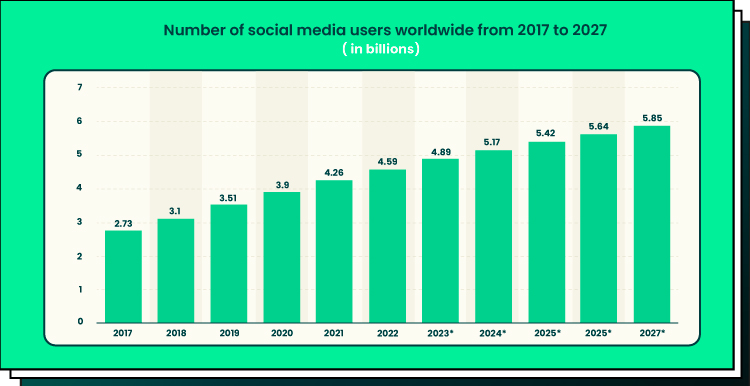As indicated in a Fortune Business Insights report, the world’s supply chain management industry was worth about $21.26 billion in 2022 and is expected to reach $47.29 billion by 2029. The especially active growth is traced to the North American region. The chart below proves that.

Experts claim supply chain forecasting is one of the key factors affecting successful management in this day and age. That’s why Forbytes specialists decided to provide a comprehensive description of what this type of predictive analysis stands for.
What Is the Chain-of-Custody Forecast?
The chain-of-custody forecast is the process of prognosticating the bid, price, and offer for one or several products. For a sufficient input, consumer and supplier data is combined with the data about the weather along with other disruptive external aspects.
Main indexes of supply chain forecast to help boost direct income
Probably the most significant metric is consumer demand. By prognosticating this indicator, it’s much easier for business owners to avoid running out of goods and overstocking. Such predictions help essentially reduce corporate financial losses.
Another important metric is inventory management. Careful planning empowers resource-efficient management of depots where you store and manage all the available products via modern tech.
As a result, you may quickly transfer the necessary items to the picking and packaging sections to deliver them without delays. Fast service boosts customer satisfaction in the long run. And Forbes reports that enterprises with superior consumer experiences are 5.7 times more profitable.
Lastly, using forecasting in supply chains helps set optimal prices for your products. Pricing projections are made based on prognosticating bids and offer values. This helps set the prices that keep regular customers onboard, don’t scare prospects away, and still bring substantial income.
Indexes affecting overall supply chain effectiveness
Company efficiency is a critical factor in today’s highly competitive business environment. But entrepreneurs can’t be effective if they don’t have clear chains of custody. According to Zippia, only 6% of enterprises could establish transparent supply systems. At the same time, 69% of firms have difficulties in this aspect. You can improve the situation by forecasting supply chain metrics, though.
Predictive analysis may benefit your overall business efficiency in the following ways:
- Reducing the percentage of cancellations and returns. You can draw the right conclusions based on the information about past rejections and come up with some approaches that will decrease the number of cancellations. Projection, in turn, will help determine the most effective attitudes.
- Choosing reliable carriers. You may predict the effectiveness of certain transporters during particular periods in the future based on fuel prices, seasonal surges in delivery services, their previous working experience, etc.
- Coming up with accurate schedules of labor force demand. Here, seasonal bursts of your products’ popularity are prognosticated to determine the necessary number of workers during different sales or manufacturing periods.
Lastly, manufacturing business owners may employ predictive analysis to accurately plan the necessary volumes of raw materials to ensure the continuity of their production processes.
Current and Emerging Trends in Supply Chain Forecasting
Approaches to predictive analysis have essentially changed over the last decade. This is mainly because of intensive digital transformation in the business sector. For example, companies worldwide spent approximately $1.5 trillion on workflow automation in 2021.
This had increased more than fourfold by early 2023. These days, AI and machine learning (ML) technologies are particularly widely used in the chain-of-custody prognostication.
What should you know about the use of AI in predictive analysis?
First off, it’s worth noting that AI-based applications can easily integrate with plenty of different data sources. On top of that, such solutions can automatically update data in ERP systems. In the latter case, AI submits manufacturing and transfer orders, as well as daily suggested purchases, to ERP digital environments. This saves tons of time.
The use of AI in predictive analysis also has the following pros:
- low error probability, unlike in the case of manual research;
- possibility to analyze data 24/7;
- money-saving opportunities – an AI-based app may replace an entire analytical department.
Specialists advise choosing AI-based applications with comprehensive research features to get more accurate projections.
Machine Learning in predictive analysis
This technology is widely employed for demand forecasting in a supply chain. Let’s say you are looking to add a new product to your range. In such cases, entrepreneurs don’t have their own sales histories for newly-added goods. ML software, for its part, may scrape the necessary information about a new product from the web. Next, such apps can track sales patterns and predict future trends based on the collected data.
Key Demand Prediction Methodologies
You should choose only relevant supply chain forecasting methods to obtain accurate analytical results.
Among the most popular demand prediction methodologies, experts note the following ones:
- Time series analysis. Here, we need to record data points at standing intervals over set periods. In this case, the crucial variable is time. You need to set as many data points as possible to get precise outcomes.
- Regression analysis. This methodology allows testing relationships between dependent and independent variables. E.g., a business owner wants to know if their new toy shop will be popular among locals. An entrepreneur should measure distances to the nearest public transport stops, the availability of kindergartens and schools in the area, etc., to assess probable demand. Shop popularity is a dependent variable in this instance. Other factors are independent metrics.
- Collaborative forecasting. This implies combining the experience and intelligence of all stakeholders to get more accurate outcomes. Entrepreneurs may engage their partners or just third-party companies working in relevant branches in this case. The more firms involved, the more precise results you get.
- Demand sensing. This supply chain forecasting method implies integrating one’s warehouse management system with several others. This way, you and your partners can quickly and effectively replenish products by predicting the demand at different depots.
Entrepreneurs can gain more accurate projections if they combine the described methodologies.
Best Practices for Accurate Demand Forecasting
As was mentioned above, it’s worth using web scraping software for predictive analysis. This is because data collection applications can mine even well-hidden information. You, however, shouldn’t collect personal details or copyrighted content in this case.
Other tips on increasing prognostication accuracy we can give are:
- Incorporate historical data to track trends over longer periods. This is especially helpful if you use the time series methodology.
- Consider recurring market trends and seasonal demand shifts. These factors commonly depend on the industry in which you do business.
- Take into account the current economical situation. This involves tracking new acts and regulations in your local legislature.

Finally, Forbytes.com, we also highly recommend following social media sentiment. According to Statista, 4.56 billion people worldwide used public networks in 2022. And this number should hit 5.85 bln by 2027. No other place contains detailed information about so many people’s preferences. This is why you should collect data from there.
Supply Chain Risk Management
Business owners should be aware of all potential risky situations in their workflows. Experts note a range of external (e.g., financial possibilities of suppliers or demand problems) and internal risks (e.g., staff shifts, absence of plans for force majeure, etc.).
Using supply chain forecasting, you can avoid probable difficulties or at least develop effective scenarios to fix potential issues. Such an approach allows entrepreneurs to quickly solve suddenly appearing problems. This, in turn, helps escape outages and speed up workflows.
Experts, however, recommend not only predicting risks for all stakeholders before signing contracts but also setting certain standards within supply chains as well as teaching employees how to act in unexpected situations. You will never be taken by surprise using such a strategy.
Collaboration and Information Sharing
FinancesOnline.Com states that cooperation may drive 10% productivity enhancements. This is fair for both ordinary employees and companies in general. The same is true for forecasting in a supply chain. You, however, should share information only with reliable partners. Otherwise, data leaks may happen.
It was mentioned below that data sharing is especially useful when employing collaborative and demand-sensing prognostication methods. That’s because you obtain information in real time and can react to changes that may cause unpredictable consequences faster. As a result, the prediction process becomes plainer.
Measuring Forecasting Performance
It’s essential to measure the effectiveness of projections systematically. Only this way can you detect flaws and make needed adjustments so that the predictions become more precise.
The key prognostication accuracy KPIs you need to measure are:
- Forecast error. This is the plainest KPI. Its formula is 1-(ABS(Dt-Ft)/Dt).
- Mean forecast error (Bias). That’s a great method to check how accurate your projection approach is. Bias=(∑(Dt-Ft))/n.
- Mean absolute percentage error (MAPE). This is the most popular methodology. It allows you to determine a percentage of relative error. MAPE=∑(Et/Dt |/n*100.
- Weighted MAPE (WMAPE). Here, you can attribute more weight to certain prognostication periods that are more significant. WMAPE-∑(IDt-FtI)/∑(Dt).
In all specified formulas, Dt is an actual metric, and Ft is a predicted value. Both are for a period of t. And n is the number of prognostications.
Case Studies and Real-Life Examples
Experts may name numerous benefits of forecasting in a supply chain. But all the theoretical advantages mean nothing without real-world examples.
The following companies have already benefited from the chain-of-custody predictions:
- More Retail. The Indian food retail enterprise is a leader in its niche. However, it had plenty of issues related to delivery and inventory management due to poor planning. Digital forecasting helped the company grow sales prognostication accuracy by 49%. This, in turn, allowed for reducing corporate losses by 20%.
- Axiom Telecom. This Middle West brand is the most successful company in its region’s smartphone and other tech industries. It suffered from ineffective planning due to manual demand projection. Digital prognostication assisted the enterprise in increasing the efficiency of its stock management optimization by 15%.
- Sunsweet Growers. The brand is a manufacturer and seller of dried fruit and juice. It suffered from extremely high production spending because of bad planning. Forecasting supply chain tools helped the company achieve a 100% return on funding. In turn, this reduced the overtime hour usage index by 17%.
Gartner claims 80% of entrepreneurs consider automated features may apply to any kind of business solution. And this is particularly true for chain-of-custody prognostications.
Final Words
Forecasting in a supply chain is an excellent way to improve your company’s competitiveness and reduce corporate expenses. However, you should choose the best-fitting prediction methodologies to get accurate results.
It’s also important to regularly check projection model performance and make necessary adjustments when conducting predictive analysis. The effectiveness of chain-of-custody forecasting is proven by numerous real-life examples worldwide. Contact specialized experts at forebytes.com to get more info on this topic.

Our Engineers
Can Help
Are you ready to discover all benefits of running a business in the digital era?

Our Engineers
Can Help
Are you ready to discover all benefits of running a business in the digital era?







